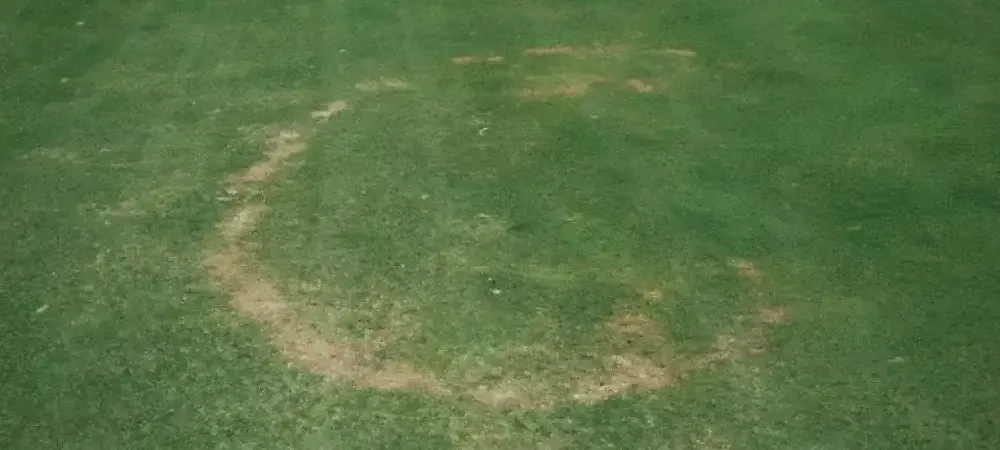What Is Necrotic Ring Spot And How Does It Affect Your Lawn?

What Is Necrotic Ring Spot?
Necrotic ring spot (NRS) is a turfgrass disease that affects both cool-season grasses and warm-season grasses. Also known as "frog-eye", the disease is caused by a species of soil-borne fungi called Ophiosphaerella korrae. These fungi infect the roots and crowns of grasses, causing them to produce small, dark brown lesions. Over time, these lesions can expand and coalesce, leading to large circular patches of dead grass. Necrotic ring spot is most active in wet or humid conditions and is often seen in early spring or late fall.
Symptoms Of Necrotic Ring Spot Disease
The most obvious symptom of NRS is the presence of small, dark brown lesions on the leaves of affected grasses that cause rings of dead grass. These lesions are typically circular in shape and about 0.25-0.5 inches in diameter. They may be surrounded by a yellow halo, and can eventually coalesce to form large patches of dead grass. Under drought conditions, these areas of infected plants can get as large as 2-3 feet in diameter.
The fungi that cause NRS can also infect the roots and crowns of plants, leading to stunted growth and yellowing leaves. In severe cases, the entire plant may die.
What Causes Necrotic Ring Spot?
The rings of dead, yellow grass associated with necrotic ringspot disease are caused by a soil-borne fungus called O. korrae, which can survive year-round, but prefers a moist environment.
- Thick layers of thatch combined with soil compaction can cause shallow grass roots and poor drainage, trapping moisture underneath and creating the perfect environment for disease to take hold. This is also what encourages the growth of other lawn diseases, including summer patch, brown patch, and snow mold.
- Improper mowing and overwatering can also contribute to the spread of this parasite.
When Is Necrotic Ring Disease Visible?
While the disease is most active during cool, wet weather in the spring and fall. But the damaged yellow rings are most evident in the summer during dry, hot weather, as the drought stress causes the damaged root systems to collapse and the plant can die.
How To Get Rid of Necrotic Ring Spot
Unfortunately, once the necrotic ring has taken over your yard, it can be difficult to get rid of. If just a small portion of your lawn has been affected, you can dig rings out with a shovel to get rid of the disease spores. You can then fill the hole with potting soil and a ryegrass seed mixture.
Once the fungus is established in an area, it can be difficult to manage. Cultural practices such as proper mowing and fertilizer application can help reduce the severity of symptoms, but may not completely eliminate the disease. We recommend that you:
- Avoid overwatering and excessive fertilizer application will help reduce the risk of infection.
- Maintain a vigorous lawn by mowing regularly and to the proper mowing height.
- Aerate compacted soils will also help prevent the disease.
- Properly remove and dispose of any affected grass clippings to prevent the fungi from spreading.
Chemical control is sometimes necessary to eradicate NRS from an area. Fungicides such as chlorothalonil and propiconazole can be effective in controlling the disease if applied at the proper time and in accordance with label directions. Be sure to follow the directions on the label carefully, as fungicides can be toxic to people and animals if used improperly.
How To Prevent Necrotic Ring Spot
The best preventative measure is to develop good lawn care maintenance habits.
- Aerate Regularly: Liquid aeration is the process of removing plugs of soil from the ground. This breaks up compact layers of soil and thatch build-up, giving your soil and grass roots easier access to air, nutrients, and water. We recommend that you aerate your lawn every Fall, before Necrotic ring spots and other fungus conditions have a chance to impact the roots of your grass.
- Fertilize Carefully: Slow-release fertilizers are specially formulated to combat diseases over time. If areas of your lawn are particularly prone to fungus and disease, fertilizers that are specifically formulated to defend against mold and fungus may protect your lawn even better.
- Water Wisely: It may be tempting to water your lawn more frequently, especially during the hot summer months! But did you know that the time of day and the frequency with which your water your grass can have a very big impact on your overall lawn health? It is better to saturate your lawn with about 1” of water once a week. Watering multiple times can lead to excess moisture, which can lead to rot and molding at the roots of your grass.
- Consider Fungicide Applications: Most homeowners don't realize that fungicides cannot be used to cure damaged grass. Preventative fungicide treatments can protect the healthy roots of your grass from further damage. They can be used in the fall, but spring application is the most effective.
Call The Professionals
If the area is so infected that removing the rings would be unreasonable, the best course of action is to work with a local team of professionals to take back control of your lawn.
If you need help diagnosing and battling necrotic ring spots in your yard, the trained professionals at American Turf and Tree Care are here to help! With our extensive lawn care program in Windsor, Greeley, and the surrounding area, just give us a call today!
